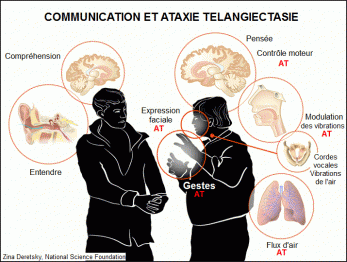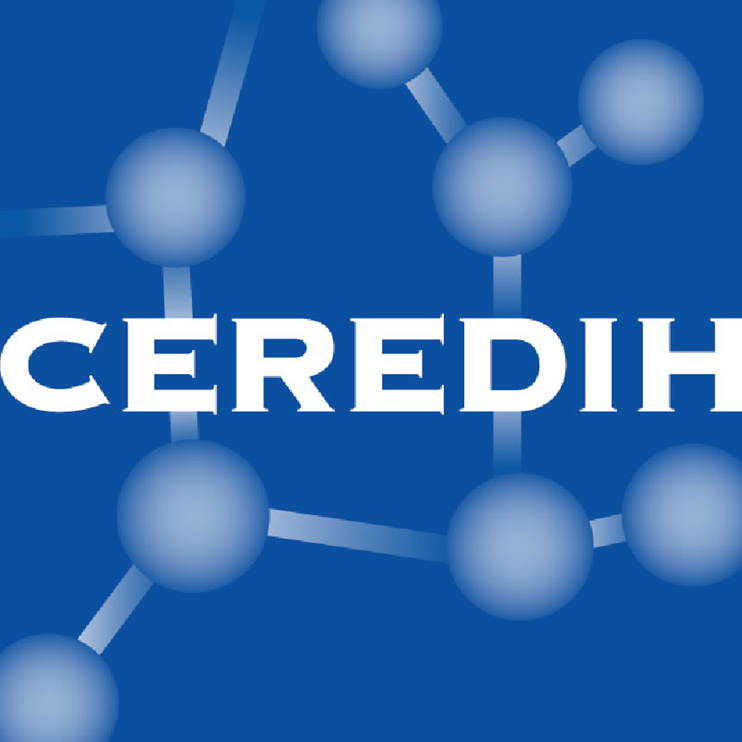Communication by speech and expression is also impaired in ataxia telangiectasia.
Talk is an effort to patients with AT, which increases their fatigue.
These patients need time to express themselves, so man has to be careful and do not stop at their facial expressions that rarely reflect their actual mood of the moment.
With swallowing which could have joined also this chapter, the degeneration of the cerebellum may cause difficulties in speech articulation and control of facial expressions in patients with AT.
Mechanism of speech
Talking consists in emitting a series of coded sounds understandable by others.
The code of speech, the language, is a purely cognitive mechanism connected to the brain as evidenced by the diversity of languages ??spoken on Earth.
 However, produce sounds and reflect his emotions by his gestures and expressions is a neuromuscular phenomenon involving:
However, produce sounds and reflect his emotions by his gestures and expressions is a neuromuscular phenomenon involving:
- the brain
- peripheral nerves
- the throat
- the mouth
- the chest (breath)
The process of speech is as follows:
- muscles of the chest (rib cage, diaphragm and abdomen) regulates the expiration to modulate the intensity of sound, its length and pauses between breaths
- sound is produced during the passage of air through the larynx and vocal cords
- articulation is ensured by the muscles of the mouth: the cheeks, tongue, lips and palate to punctuate the sounds.
Speaking difficulties
The interconnections between the different functions are numerous in the face (jaw , tongue and face mobility, absorption, swallowing, breathing, ...). When one or more systems are affected, many difficulties may occur. This is the case for Ataxia Telangiectasia but in this area too, difficulties are different among concerned people. The neurological disorder disturbs the smooth coordination of all muscles involved in the process of speech and expression of emotions in the face. In addition, due to lung infections, respiratory capacity of people with AT can be reduced. The combined effects of these factors are:
- People with AT have gradually trouble to start their sentence: the thought is clear but the action does not follow. They need more time to speak, which may suggest that they are reluctant, that they do not have the knowledge or are indifferent.
- Efforts are noticeable on the face and expressions do not necessarily reflect the meaning of the sentence.
- Then, the flow of words can be very fast but then the sentence will be short.
- Sometimes, even if known, some AT patients have trouble finding a word which can make discussions around a specific vocabulary difficult.
- Articulation difficulties can make the words harder to understand.
Communication difficulties
 Consequences are numerous and various:
Consequences are numerous and various:
- On the physical level, people with AT have to provide huge efforts to speak, which may end by tiring and discouraging them to express themselves in society.
- Communication attitudes and expressions are at least as important as speaking: having a hypotonic face not accompanying emotions with expressions that match is a handicap in communication.
- The communication from AT patients may be prone to misinterpretation, especially at school.
- Communication is essential in the social life of a person. Imagine having all your thought and not being able to express it spontaneously, without a significant effort and the risk of not being understood the first time! On the psychological level, frustration is the first feeling taking hold.
Solutions
The immediate solutions are simple to implement. They are:
- Inform the whole family, teachers , friends ...
- Be patient, allow time for the person with AT to speak and especially terminate, not wanting to help finish by completing the end of his sentences.
- Maintain good lung capacity by a suitable work of physical therapy, sport activities and basic precautions to keep away from infections.
- Handle the psychological aspect of this difficulty which, if not the worst on the single criterion of dangerousness, is paramount in the construction of children with AT.
- Consult a SLP who may, at first, assess the disability and follow it and secondly, propose a number of techniques for improving articulation. qui pourra, dans un premier temps, évaluer ce handicap et en assurer un suivi et, dans un deuxième temps, proposer un certain nombre de techniques susceptibles d'améliorer l'articulation.





